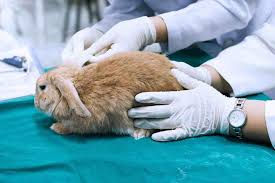Desexing and Reproductive Health: What Every Rabbit Owner Should Know
- Loz
- Aug 16
- 4 min read

Understanding the Advantages of Desexing, Reproductive Behaviours, and How to Care for Your Rabbit After Surgery
Desexing, also known as spaying (for females) or neutering (for males), is a routine surgical procedure recommended for most rabbits in Australia. Beyond helping to control the pet population, desexing offers a range of health and behavioural benefits for your furry mate. This blog post will walk you through why desexing is important, what reproductive behaviours you might notice in intact (non-desexed) rabbits, and provide a step-by-step guide to caring for your rabbit after surgery.
Benefits of Desexing (Spaying and Neutering)
Healthier Pets: Desexed rabbits are less likely to develop certain cancers and infections, such as uterine infections (pyometra) in females and testicular cancer in males. Spaying also eliminates the risk of ovarian and uterine cancers.
Better Behaviour: Desexed rabbits generally display fewer undesirable behaviours. Males are less likely to spray by marking territory with urine or show aggression. Females will not be able to reproduce, which reduces restlessness, reduces aggression and attracting unwanted male attention.
Population Control: Desexing helps reduce the number of unwanted litters, easing the burden on animal shelters (kike the RSPCA) and helping more pets find loving homes.
Improved Longevity: Studies have shown that desexed rabbits often live longer, healthier lives.
Understanding Reproductive Behaviour
Intact rabbits exhibit natural reproductive behaviours driven by hormones. In females, being ready to reproduce 24/7 can result in dominance/agression, and attracting male rabbits from the neighbourhood. Wild males may roam searching for a mate, with domestic males becoming territorial, and act aggressively. These behaviours can lead to accidents, injuries, or death.
Desexing removes or reduces these hormonal influences, leading to a calmer, more predictable rabbit who is safer and happier at home.
Pre-Surgery Preparation
If your vet tells you withhold food and water from your rabbit in the days/hours leading up to your bun buns surgery, DO NOT DO THIS. You rabbit needs access to food and water right up until the surgery starts. This is due to their digestive systems (they are extremely similar to horses) requiring constant food and processing throughout. In light of this, make sure you pack plenty of their favourite snacks, hay and water in their pet carrier for their trip to the vet.
If you vet tells you to withhold food and water, they are definitely not rabbit-savvy, and I suggest you find one that is, pretty quickly! Or if you feel comfortable, let them know this is not a scientifically backed approach for rabbits.
Step-by-Step Guide to Post-Surgery Care
Caring for your rabbit after desexing is straightforward but important for a smooth recovery. Here’s a handy guide to help your mate bounce back quickly:
Rest and Recovery Space:
Set up a quiet, warm, comfortable area away from other pets, and children. (Our property has underfloor heating which helps, but a microwaveable heat pad works wonders in this space. Recommend: SnuggleSafe
Keep your rabbit indoors for at least 10–14 days after surgery.
Monitor the Surgical Site:
Check the incision daily for swelling, redness, discharge, or unusual odours.
Prevent your rabbit from licking or chewing at the stitches—it is preferable not to use a cone as rabbits cannot reach their feed or water (which is critical for their recovery and ultimate survival post-surgery. Again, if the vet puts one on, take it off as soon as possible).
Apply a healing cream to help reduce the risk of infection. Recommend: Flamzine cream (vet prescription, so please request from your vet)

Limit Activity:
No overactivity until your vet gives the all-clear.
Short, supervised run arounds outside (usually 2 days post-surgery) only if needed, as advised by your vet.
Feeding:
Your pet may have a reduced appetite for the first 24 hours. Encourage eating by giving your rabbit Oxbow Critical Care, along with greens and their favourite treats, whilst continuing to have access to unlimited hay and water. Recommend: Oxbow Critical Care (vet can supply this)
Watch for pain or signs of discomfort.
Medication:
Give any prescribed pain relief or antibiotics as directed by your vet. This is generally meloxicam and administered by small syringe. The vet will provide the recommended dosage based on your rabbit's weight.
Never give human medicine to pets.
Follow-Up:
Your vet may want to check the incision or remove stitches after 10–14 days.
Contact your vet immediately if you notice bleeding, swelling, loss of appetite, inactivity, or if your pet seems very unwell.
Conclusion
Desexing is one of the most responsible choices you can make as a rabbit owner in Australia. It not only improves your rabbit's health and wellbeing but also contributes to the greater good by preventing unwanted litters. By understanding reproductive behaviours and following proper post-surgery care, you’ll set your furry friend up for a long, happy, and healthy life. If you have any questions, always check in with your local vet—they’re there to help!
For people in the Canberra region, I cannot recommend Dr Mae of Hoppy Housecalls enough for your specialist bun bun vet! She's a rabbit specialist and is so kind with your fur babies. Book in with her to get your bun vaccinated.




Comments